Creating a Test Plan - MIC 2.4G
Basic Settings:
WiFi
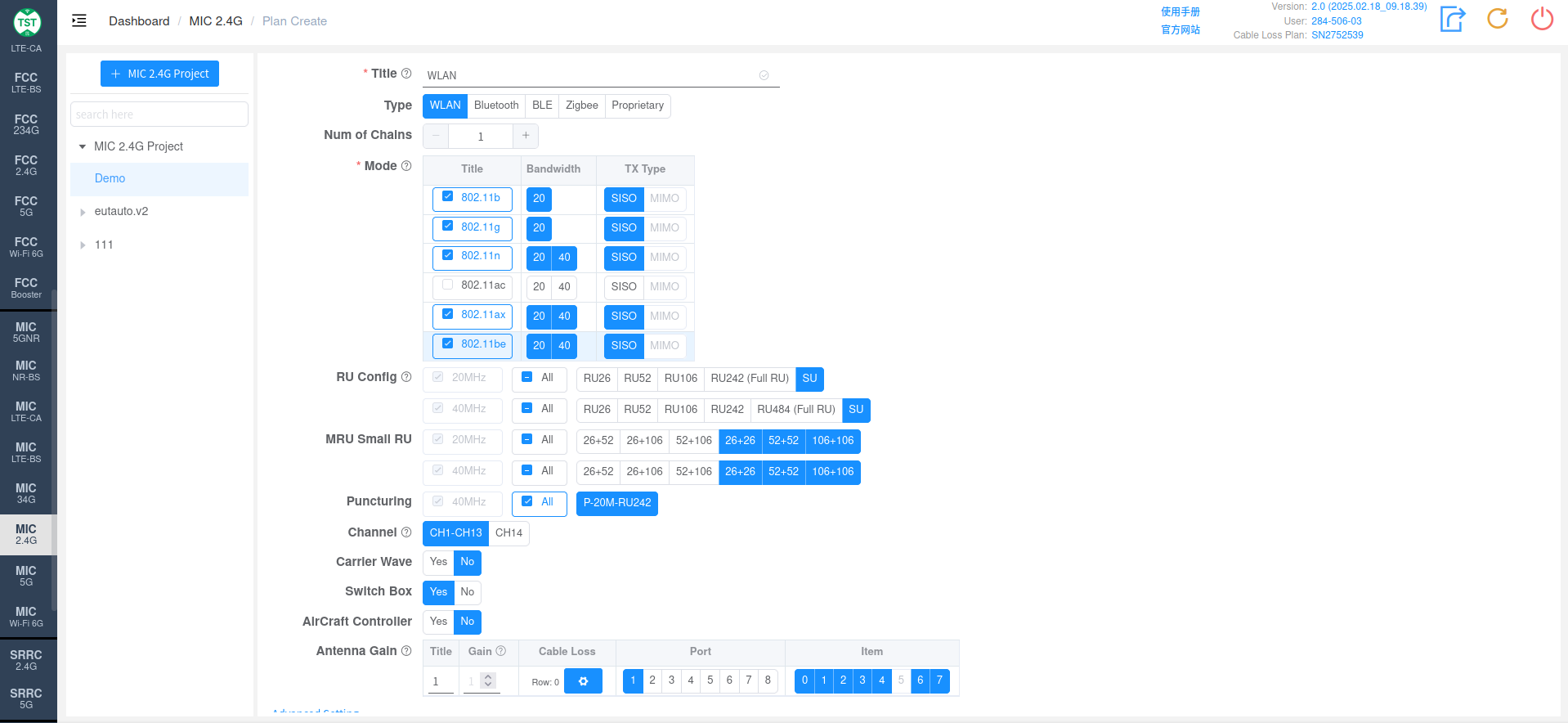
Type: Technical Category, WLAN
Num of Chains: Number of transmit chains (antennas) the product has.
Mode: Modes supported by the product, e.g., 802.11b/g/n/ax... for WiFi, or GFSK, 8DPSK, etc. for Bluetooth.
RU Config: RU configuration supported by 802.11ax devices. Full RU for each bandwidth is mandatory; other RU configurations should be selected based on the product's actual support.
Channel: The default is to test CH1~CH13. If the product also supports CH14, select CH14 as well.
Carrier Wave: Whether the product supports carrier wave transmission. If Yes is selected, the frequency error will be measured using carrier mode, and the test setup will be significantly different from modulated signal testing.
Switch Box: Whether to use a Switch Box. If a Switch Box has not been purchased, select No for this item, and the product will be directly connected to the spectrum analyzer for testing.
AirCraft Controller: Confirm whether the product is an aircraft controller, the default is No.
Antenna Gain:
Title: Antenna number, named sequentially by default as 1, 2, 3, 4..., or manually input other names according to customer requirements.
Gain: Gain of each antenna in the corresponding frequency band.
Cable Loss: Cable loss of the RF cable from the product's antenna port to the Switch Box (RF port of the switch) or SA (Spectrum Analyzer, if not using a switch directly). How to Create Common Cable Loss.
Port: Port number of the switch connected to the product's antenna, e.g., Ant1 connected to port 1, Ant2 connected to port 2.
Item: List of all test items included in this standard. *For known product types such as WIFI, Bluetooth, BLE, Zigbee, etc., the software has selected the default required test items based on their respective technical characteristics. Of course, you can also select some items for testing according to your testing needs. Note: In some standards, test parameters are mutually referenced between items. If only some items are checked, the test may not be able to proceed. Therefore, it is recommended to create a test plan using the default items directly. For multi-antenna products, to reduce workload, the first antenna will by default perform tests for all applicable items. However, other antennas have had some mandatory test items selected according to standard requirements. For non-mandatory items, you can check them yourself as needed.
Bluetooth
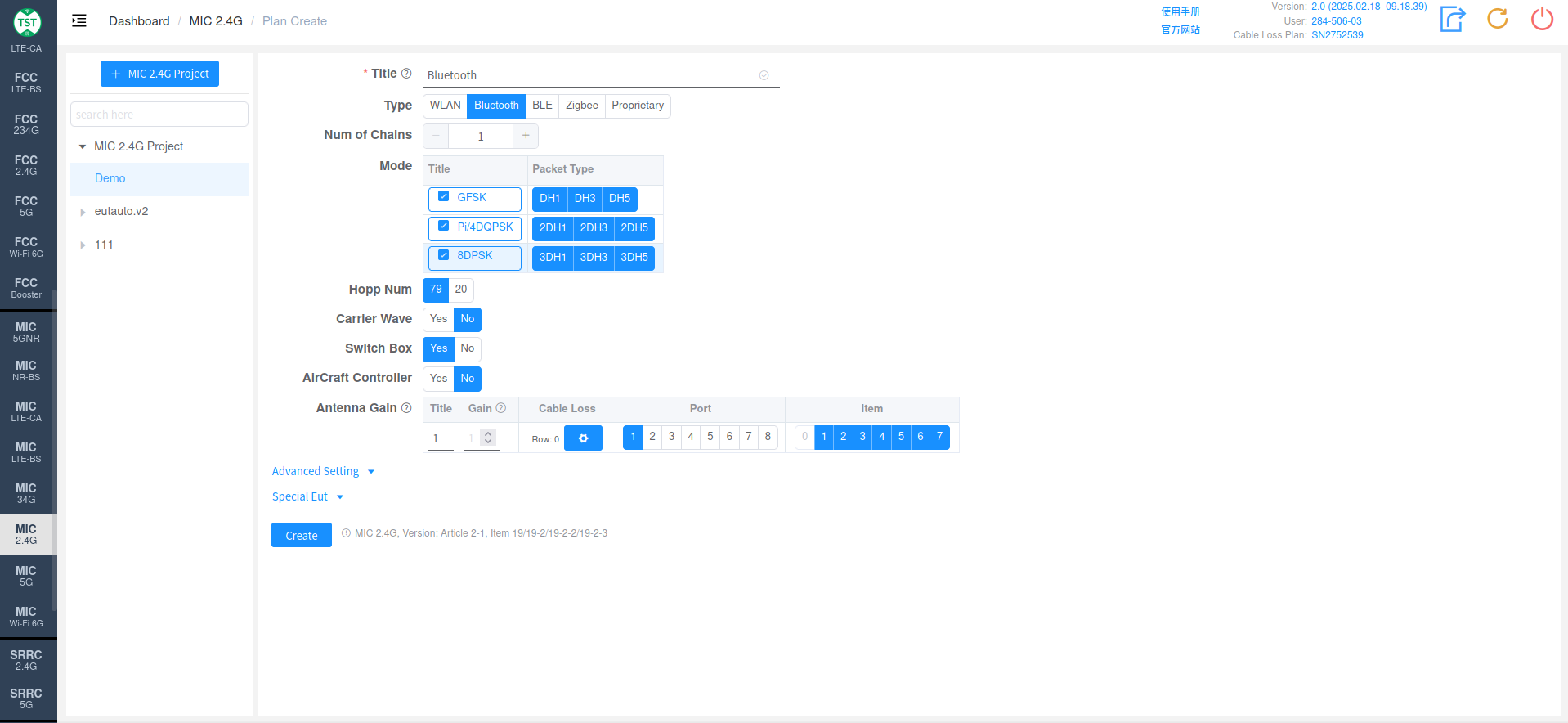
Type: Technical Category, Bluetooth
Num of Chains: Number of transmit chains (antennas) the product has. Bluetooth currently only supports single antenna.
Mode: Modes and Packet Types supported by the product.
Hopp Num: Bluetooth defaults to testing 79 channels. Some Japanese regulatory agencies require additional power measurement results under 20 channel conditions when performing power tests. If this is required, select both 79 and 20 channels.
Carrier Wave: Whether the product supports carrier wave transmission. If Yes is selected, the frequency error will be measured using carrier mode, and the test setup will be significantly different from modulated signal testing.
Switch Box: Whether to use a Switch Box. If a Switch Box has not been purchased, select No for this item, and the product will be directly connected to the spectrum analyzer for testing.
AirCraft Controller: Confirm whether the product is an aircraft controller, the default is No.
Antenna Gain:
Title: Antenna number, named sequentially by default as 1, 2, 3, 4..., or manually input other names according to customer requirements.
Gain: Gain of each antenna in the corresponding frequency band.
Cable Loss: Cable loss of the RF cable from the product's antenna port to the Switch Box (RF port of the switch) or SA (Spectrum Analyzer, if not using a switch directly). How to Create Common Cable Loss.
Port: Port number of the switch connected to the product's antenna, e.g., Ant1 connected to port 1, Ant2 connected to port 2.
Item: List of all test items included in this standard. *For known product types such as WIFI, Bluetooth, BLE, Zigbee, etc., the software has selected the default required test items based on their respective technical characteristics. Of course, you can also select some items for testing according to your testing needs. Note: In some standards, test parameters are mutually referenced between items. If only some items are checked, the test may not be able to proceed. Therefore, it is recommended to create a test plan using the default items directly. For multi-antenna products, to reduce workload, the first antenna will by default perform tests for all applicable items. However, other antennas have had some mandatory test items selected according to standard requirements. For non-mandatory items, you can check them yourself as needed.
BLE
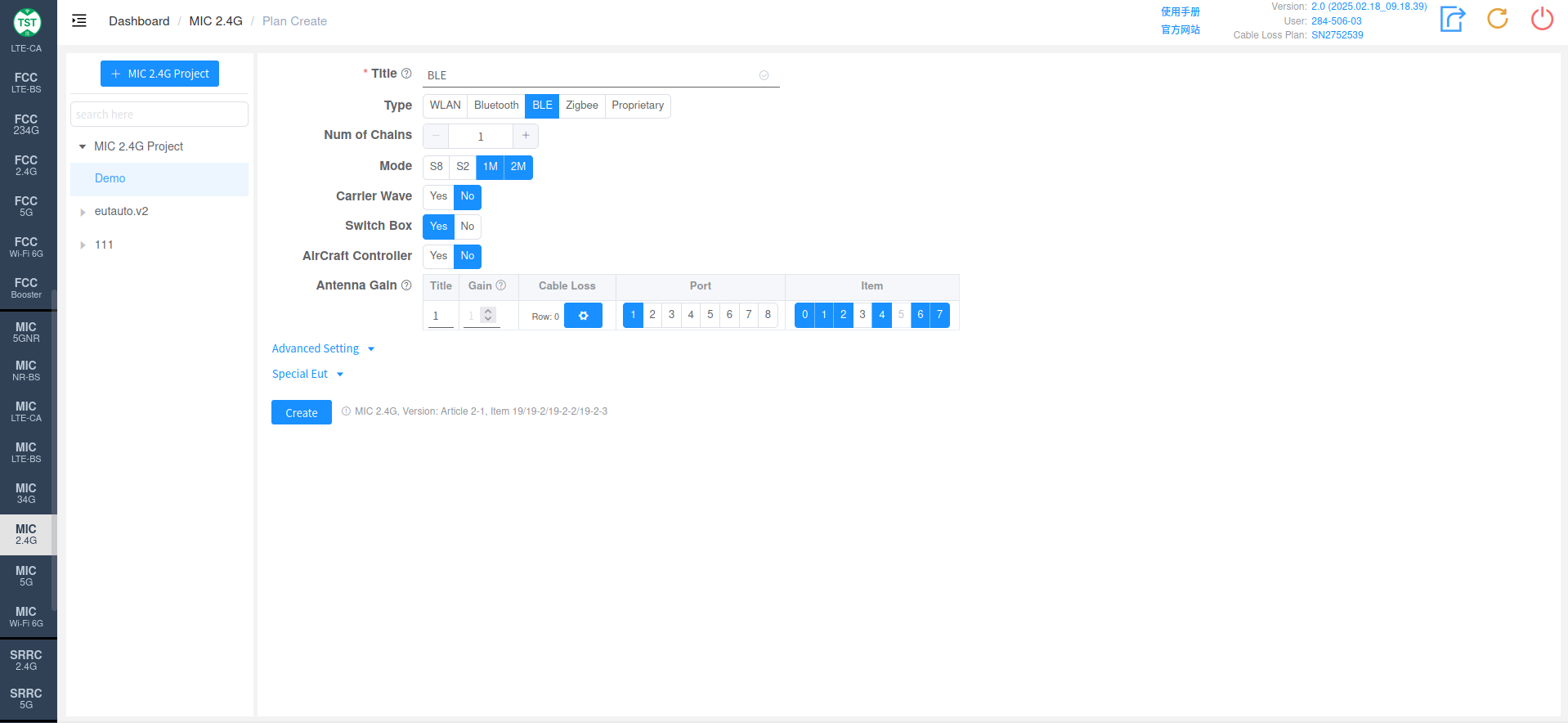
Type: Technical Category, BLE
Num of Chains: Number of transmit chains (antennas) the product has. BLE currently only supports single antenna.
Mode: Modes supported by the product. *In protocol versions prior to BT 5.0, BLE only had a 1Mbps rate. However, starting with version 5.0, in addition to retaining the 1Mbps rate, two new rates for Long range scenarios, S8 and S2 (corresponding to 125kbps and 512kbps respectively), and a 2Mbps rate for high-bandwidth scenarios were introduced for IoT products. Among these, the 1Mbps rate is mandatory for version 5.0 and above, while the other three rates are optional. In addition, the S8 and S2 rates are implemented by adding FEC (Forward Error Correction) functionality on top of the 1Mbps rate, and their symbol rate is still 1Mbps. Therefore, from the actual test results, the test results of the S8, S2, and 1M modes are basically the same. Therefore, for products that support these three rates simultaneously, generally only the 1M mode is tested. (If only the 1M mode needs to be tested, just select the 1M mode. If all three modes, S8, S2, and 1M, are selected, the software will test these three modes separately.)
Carrier Wave: Whether the product supports carrier wave transmission. If Yes is selected, the frequency error will be measured using carrier mode, and the test setup will be significantly different from modulated signal testing.
Switch Box: Whether to use a Switch Box. If a Switch Box has not been purchased, select No for this item, and the product will be directly connected to the spectrum analyzer for testing.
AirCraft Controller: Confirm whether the product is an aircraft controller, the default is No.
Antenna Gain:
Title: Antenna number, named sequentially by default as 1, 2, 3, 4..., or manually input other names according to customer requirements.
Gain: Gain of each antenna in the corresponding frequency band.
Cable Loss: Cable loss of the RF cable from the product's antenna port to the Switch Box (RF port of the switch) or SA (Spectrum Analyzer, if not using a switch directly). How to Create Common Cable Loss.
Port: Port number of the switch connected to the product's antenna, e.g., Ant1 connected to port 1, Ant2 connected to port 2.
Item: List of all test items included in this standard. *For known product types such as WIFI, Bluetooth, BLE, Zigbee, etc., the software has selected the default required test items based on their respective technical characteristics. Of course, you can also select some items for testing according to your testing needs. Note: In some standards, test parameters are mutually referenced between items. If only some items are checked, the test may not be able to proceed. Therefore, it is recommended to create a test plan using the default items directly. For multi-antenna products, to reduce workload, the first antenna will by default perform tests for all applicable items. However, other antennas have had some mandatory test items selected according to standard requirements. For non-mandatory items, you can check them yourself as needed.
Zigbee
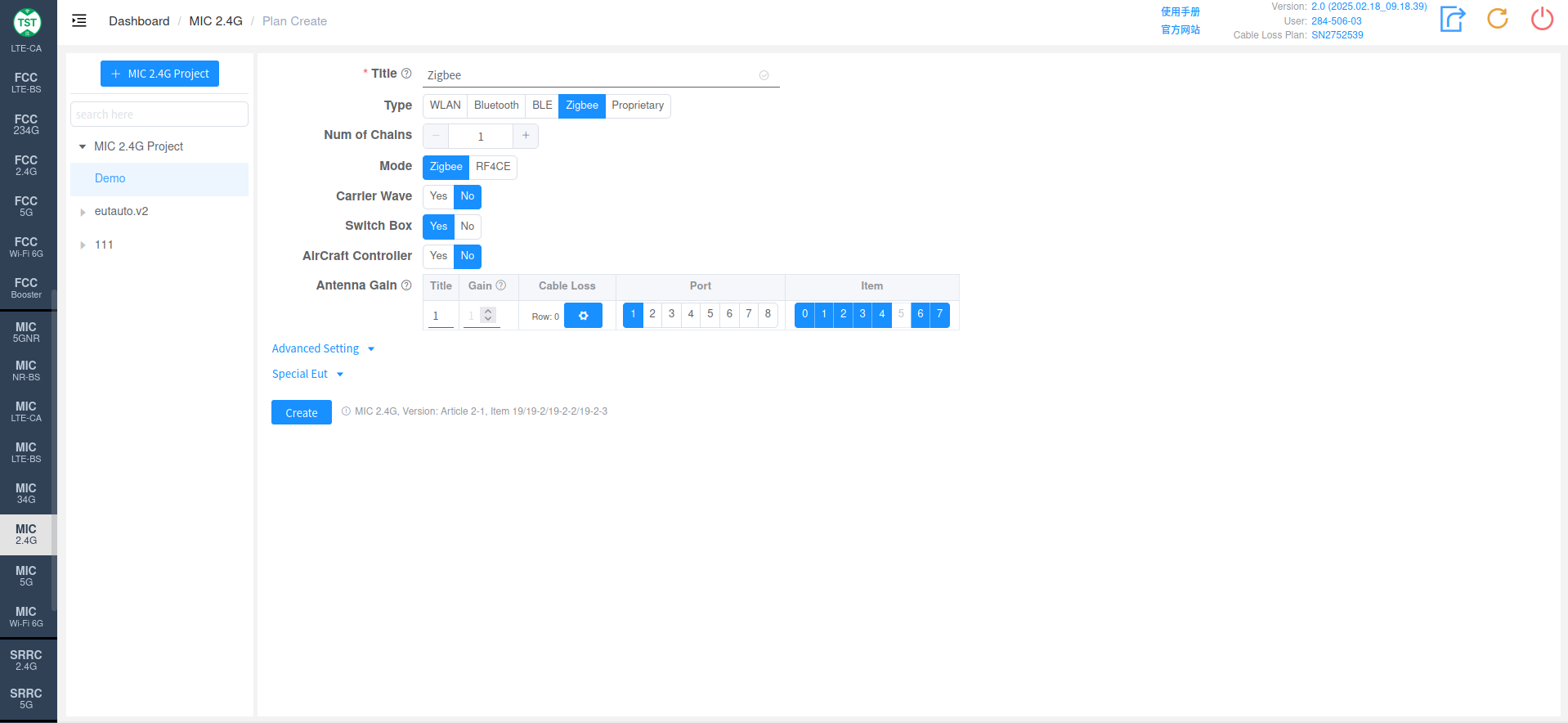
Type: Technical Category, Zigbee
Num of Chains: Number of transmit chains (antennas) the product has.
Mode: Modes supported by the product. Zigbee or RF4CE
Carrier Wave: Whether the product supports carrier wave transmission. If Yes is selected, the frequency error will be measured using carrier mode, and the test setup will be significantly different from modulated signal testing.
Switch Box: Whether to use a Switch Box. If a Switch Box has not been purchased, select No for this item, and the product will be directly connected to the spectrum analyzer for testing.
AirCraft Controller: Confirm whether the product is an aircraft controller, the default is No.
Antenna Gain:
Title: Antenna number, named sequentially by default as 1, 2, 3, 4..., or manually input other names according to customer requirements.
Gain: Gain of each antenna in the corresponding frequency band.
Cable Loss: Cable loss of the RF cable from the product's antenna port to the Switch Box (RF port of the switch) or SA (Spectrum Analyzer, if not using a switch directly). How to Create Common Cable Loss.
Port: Port number of the switch connected to the product's antenna, e.g., Ant1 connected to port 1, Ant2 connected to port 2.
Item: List of all test items included in this standard. *For known product types such as WIFI, Bluetooth, BLE, Zigbee, etc., the software has selected the default required test items based on their respective technical characteristics. Of course, you can also select some items for testing according to your testing needs. Note: In some standards, test parameters are mutually referenced between items. If only some items are checked, the test may not be able to proceed. Therefore, it is recommended to create a test plan using the default items directly. For multi-antenna products, to reduce workload, the first antenna will by default perform tests for all applicable items. However, other antennas have had some mandatory test items selected according to standard requirements. For non-mandatory items, you can check them yourself as needed.
Proprietary
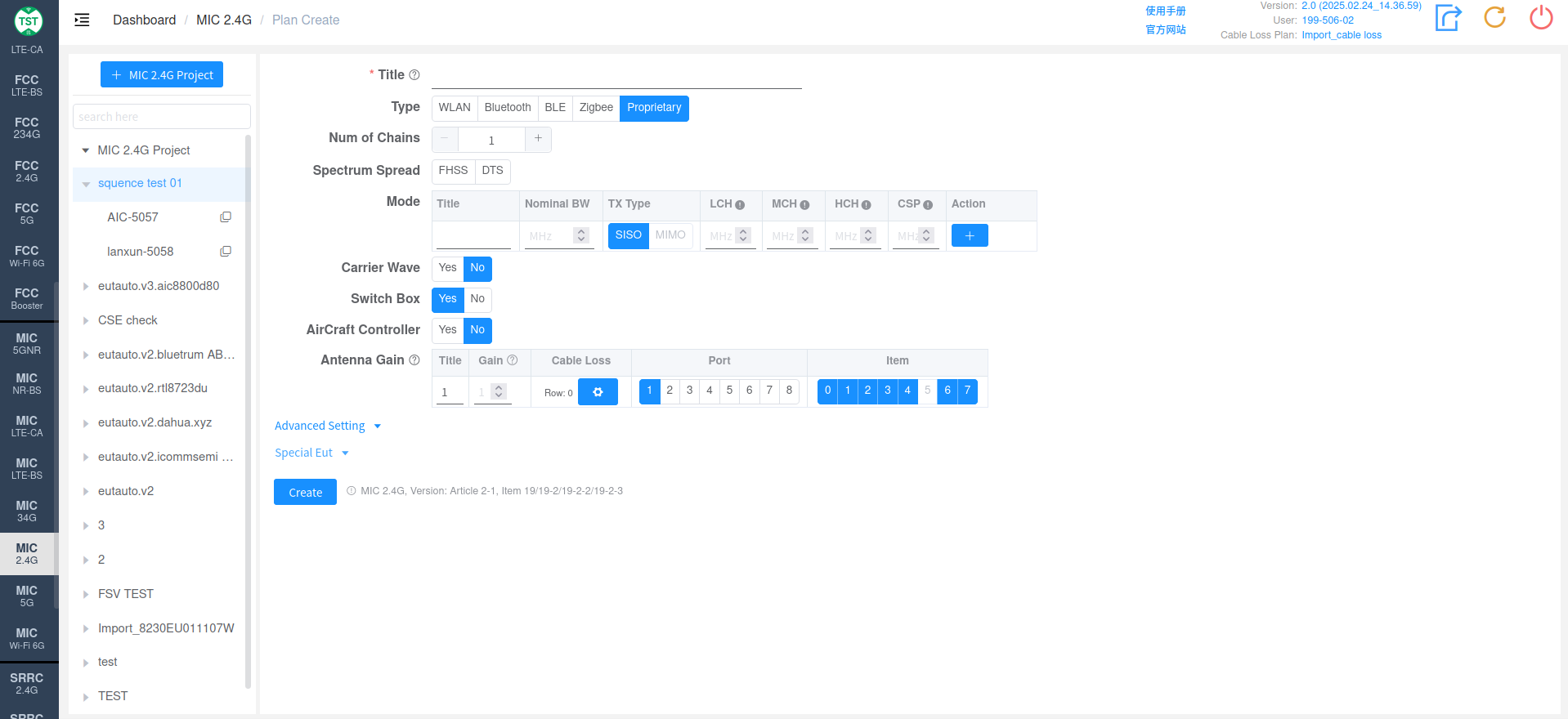
Type: Technical Category, Proprietary
Num of Chains: Number of transmit chains (antennas) the product has.
Spectrum Spread: Select the spectrum spreading method.
FHSS : Frequency Hopping Spread Spectrum. Transmits signals by rapidly switching (hopping) through a set of known frequencies, thus dispersing the signal across the spectrum. The advantage is reduced interference and improved security, as eavesdroppers find it difficult to lock onto and decode the signal without knowing the hopping sequence.
DTS : Systems using digital modulation techniques may operate in the 902-928 MHz, 2400-2483.5 MHz, and 5725-5850 MHz bands. The minimum 6 dB bandwidth shall be at least 500 kHz.
Mode:
Title: Mode number, manually input other names according to customer requirements.
Nominal BW: Set the predetermined bandwidth occupied by the signal on the spectrum.
TX Type: Set the transmission type.
SISO: Single Input Single Output. A basic wireless communication transmission method that uses a single antenna for transmitting and receiving.
MIMO: Multiple Input Multiple Output. This transmission method uses multiple antennas to transmit and receive data simultaneously, which can improve communication capacity and reliability.
LCH: Low Channel setting, used to specify the lowest frequency at which communication begins, in MHz.
MCH: Middle Channel setting, used to specify the center frequency of communication.
HCH: High Channel setting, used to specify the highest frequency of communication.
CSP: Channel Spacing, defines the frequency distance between channels. This is very important for broadband communication or devices where multiple channels operate simultaneously.
Action: Used to add new mode configurations.
Carrier Wave: Select whether it is a carrier wave.
Switch Box: Whether to use a Switch Box. If a Switch Box has not been purchased, select No for this item, and the product will be directly connected to the spectrum analyzer for testing.
AirCraft Controller: Confirm whether the product is an aircraft controller, the default is No.
Antenna Gain:
Title: Antenna number, named sequentially by default as 1, 2, 3, 4..., or manually input other names according to customer requirements.
Gain: Gain of each antenna in the corresponding frequency band.
Cable Loss: Cable loss of the RF cable from the product's antenna port to the Switch Box (RF port of the switch) or SA (Spectrum Analyzer, if not using a switch directly). How to Create Common Cable Loss.
Port: Port number of the switch connected to the product's antenna, e.g., Ant1 connected to port 1, Ant2 connected to port 2.
Item: List of all test items included in this standard. *For known product types such as WIFI, Bluetooth, BLE, Zigbee, etc., the software has selected the default required test items based on their respective technical characteristics. Of course, you can also select some items for testing according to your testing needs. Note: In some standards, test parameters are mutually referenced between items. If only some items are checked, the test may not be able to proceed. Therefore, it is recommended to create a test plan using the default items directly. For multi-antenna products, to reduce workload, the first antenna will by default perform tests for all applicable items. However, other antennas have had some mandatory test items selected according to standard requirements. For non-mandatory items, you can check them yourself as needed.
Advanced Setting and Special Eut Settings:
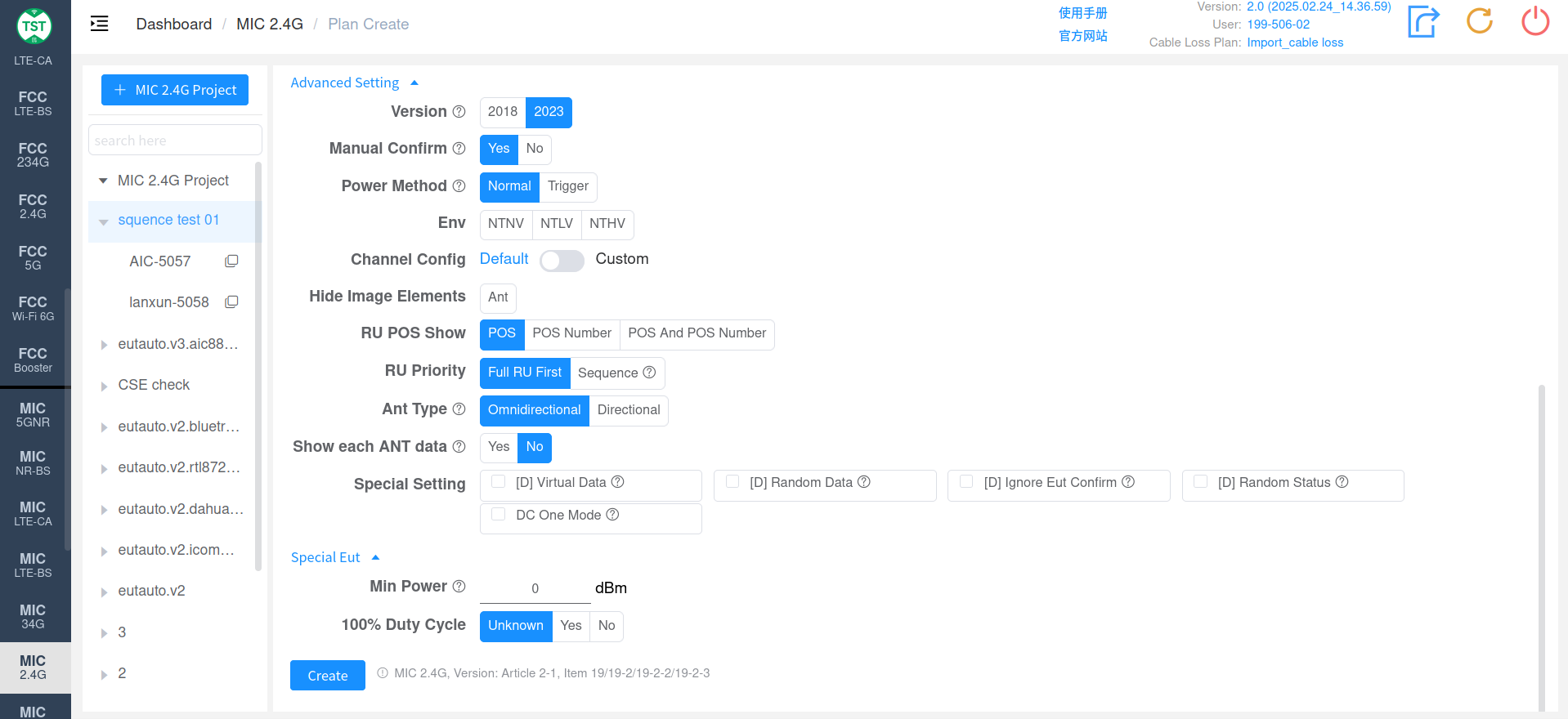
Generally, all settings in Special EUT do not need to be set. They only need to be set when the test results are abnormal.
Version: Select the version number. Click the hyperlink in the question mark to set the overall Version of the system.
Manual Confirm: Whether a pop-up window is needed to confirm if the waveform is stable. The built-in automatic waveform stability determination algorithm of this system may misjudge projects that need to be tested in frequency hopping mode because some chips hop very slowly. Therefore, this option is enabled by default for Bluetooth, and the test engineer assists in determining whether the waveform is stable.
Power Method: Confirm whether a Trigger needs to be used in Power measurement. The default is Normal, and the Trigger is not enabled. In most cases, it is recommended to use the Normal method for measurement, which can save test time; however, for some products with large power fluctuations, it is recommended to use the Trigger method for measurement to ensure that the maximum Power is captured. Using this method, the measurement time for a single power may be increased by 5 to 20 seconds, depending on the product.
ENV: Required environmental conditions for testing. e.g., NTNV, LTNV, HTNV (Normal Temperature Normal Voltage, Low Temperature Normal Voltage, High Temperature Normal Voltage).
Channel Config: Vector Signal Generator power ALC state, used for adaptive testing.
Config: Check Custom to select Config and manually configure the channel.
Hide Image Elements: Select the image elements to hide.
RU POS Show: Select to display RU POS or RU POS Number or display both together.
RU Priority: RU priority selection, Full RU priority or according to Sequence.
Ant Type: Select the antenna type, Omnidirectional or Directional.
